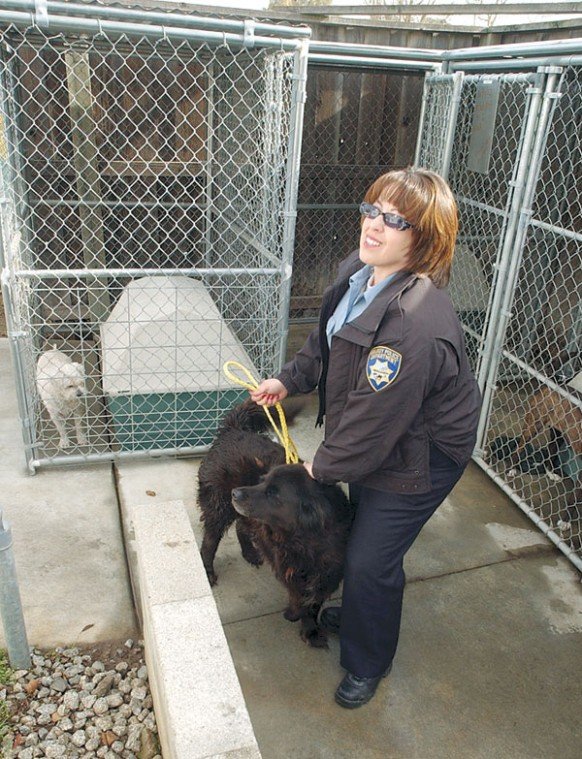GILROY
– The police department has a New Year’s resolution: To let
Gilroyans know their animal control services start in Gilroy, not
San Martin.
GILROY – The police department has a New Year’s resolution: To let Gilroyans know their animal control services start in Gilroy, not San Martin.
Given the limited size of Gilroy Police Department’s dog shelter – it has six outdoor kennels – and South County Animal Shelter’s successful adoption rate for dogs – nearly 70 percent – it’s no surprise many Gilroyans look for lost dogs at the 12370 Murphy Ave. shelter in San Martin.
But there’s a good chance the animal isn’t there, at least not yet.
Loose dogs found in Gilroy are collected by the GPD and held up to five days inside covered kennels in the department’s Rosanna Street headquarters parking lot. After five days, dogs are taken to the San Martin shelter. If no room is available there, the animals get taken to the Santa Clara Humane Society.
“We’re trying to find a way to let the public know we hold them,” said Maria Cabatingan, Community Service Officer for the GPD.
However, the San Martin shelter only services unincorporated areas. So, Gilroy animals often end up at the nearest place that will accept them, the Santa Clara Humane Society.
Cabatingan said she hopes to start an awareness campaign once more full-time Community Service Officers are hired by the GPD. Cabatingan became the lone full-time Gilroy Community Service Officer last spring when one of her fellow officers shipped off for military duty and another became a full-fledged police officer.
The depleted force left her – with roughly 11 weeks of training – as the lead animal control officer for the GPD, forcing the one-year veteran to balance that role with her other duties.
CSOs, as they are called among the police department rank and file, perform many support services for Gilroy police, from processing paperwork and reports to controlling traffic at large events or after an accident.
Cabatingan said she wants to set up a Web page on the police department’s Web site that would show digital photos, or at least describe, the animals that are being held at the Gilroy police station. Cabatingan also wants to work with local media to help draw attention to animals being held locally. She wants to place no-cost classified ads in newspapers when a dog has been found by police.
Increased awareness that lost dogs may be in Gilroy, not elsewhere, could serve several purposes beyond the obvious one.
If more people locate their animals in Gilroy, it will open more kennels for lost and abandoned dogs at the police station. Also, it would make it easier for San Martin to house the Gilroy animals that the GPD drops off there after five days.
“San Martin takes as many dogs as they can, but they only have to keep about 20 at time,” Cabatingan said. “That’s the agreement we have with them.”
When there is no room for an animal at the San Martin shelter, there is no guarantee the pet will not be euthanized.
Phil Jewitt, the animal control manager for South County Animal Shelter, says his outfit is committed to keeping dogs alive as long as possible.
“If they’re adoptable, we try to keep them,” Jewitt said. “The problem is when you have pit bulls, Rotweilers, large dogs people are scared of. They are hard to adopt and inevitably a dog has to be put down.”
So, when Gilroy builds its new $26.7 million police station, there will be plenty of space for more dog kennels, right?
Wrong, says Assistant Chief of Police Lanny Brown.
Brown said the city is committing zero square footage to animal control in the new 49,000-square-foot facility some have scoffingly called the Gilroy Taj Mahal. The decision is based on Gilroy’s commitment to impact the station’s future neighbors – who would hear the dogs barking and howling – as little as possible.
Brown also said the logical place for the kennels would be in the parking area. However, the new facility has underground parking, and to put barking dogs there would disrupt not only the neighborhood’s peace, but make it difficult for police department personnel to do their work, too.
“It’s staying where it’s at now,” Brown said. “Ultimately, the kennels will be moved some day. But it’s not something that’s going to happen in the next few years.”
Today’s animal control program took shape back in the mid 1990s when Santa Clara County cut animal control services deeply. Historically, Brown said, the county performed animal control for Gilroy, not police officers and CSOs.
“Being in the animal control business is a distraction to the core service areas of the police department,” Brown said. “It adds to the plate of our CSOs … and when they’re not available, it’s the duty of our police officers to be dogcatchers.”
The city spends up to $12,000 a year on animal control supplies and materials, which includes food for the captured dogs, cages, “come-along” hooks (leashes that make it harder for an animal to bite its handler) and a special animal carrier pickup truck.
Animal control in Gilroy does not pick up cats, unless they are injured or ill. In those cases, the cat is taken to a local vet for stabilization, and then it is moved to the San Martin shelter. The services do not come without a cost. The vet charges the police department for services and the San Martin shelter charges $100 per animal.
Residents who want to surrender an animal they cannot take care of are asked by Gilroy police to take the animal to the Humane Society or, if the animal was found in an unincorporated area, the San Martin shelter. In cases where that is not possible, the police will charge the resident $100.
Residents picking up their lost dog are charged $55 for the first 24-hour period. Each day the dog is held beyond that, the city tacks on another $15.
For residents like Mary Hohenbrink, a mayoral candidate in November and a self-proclaimed animal lover, the state of local animal control is discouraging. Although it wasn’t a key component of her campaign platform, Hohenbrink mentioned her dissatisfaction with animal control during the Gilroy City Council elections.
Based on her own everyday observations, Hohenbrink estimates there are more loose animals in Gilroy than ever before.
And currently, there are significantly more animals at the San Martin shelter compared to last year. Jewitt said 60 cats and 30 dogs were in the shelter at this time last year. This year 200 cats and 100 dogs are being housed.














